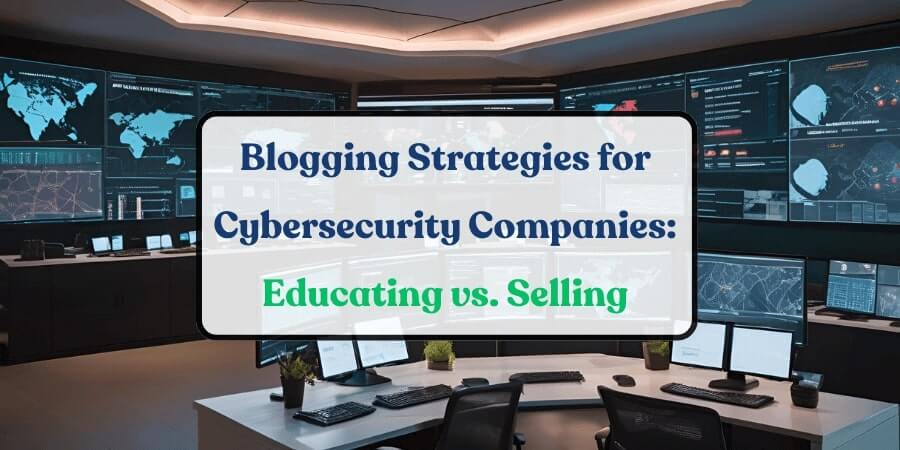Many cybersecurity firms struggle with an ineffective blogging strategy—either pushing sales too aggressively or failing to showcase their expertise. With a well-balanced cybersecurity blogging strategy, content can educate, build trust, and drive conversions—all without feeling like a sales pitch.
Cybersecurity is a critical concern for businesses of all sizes. Cyberattacks increased by 38% in 2023, according to Check Point Research, with ransomware alone causing over $1 billion in damages worldwide (IBM Security Report, 2023); making it more important than ever for companies to stay informed. However, business leaders and IT teams don’t want to be bombarded with sales pitches when they’re looking for security solutions. Instead, they seek reliable, actionable insights to help them navigate cybersecurity threats. In this blog, we’ll explore the best cybersecurity blogging strategies, focusing on how cybersecurity firms can educate their audience while strategically positioning their solutions.
The Purpose of Cybersecurity Blogging
A strong cybersecurity blogging strategy is not just about publishing content—it’s about positioning your company as a trusted resource. With cyberattacks increasing by 38% in 2023, businesses are actively seeking reliable information on how to protect themselves. A blog can help cybersecurity firms:
- Establish authority in Cybersecurity by sharing insights on the latest threats, compliance updates, and best practices.
- Educate potential customers through detailed guides, case studies, and security awareness content.
- Generate leads with Thought Leadership by addressing industry pain points and offering solutions in a non-intrusive way.
However, many companies miss the mark by making their blogs overly promotional, which can drive readers away instead of engaging them.
Educating: Building Trust Through Knowledge Sharing
The foundation of any successful cybersecurity blogging strategy is education. When businesses or IT teams look for security solutions, they aren’t searching for sales pitches—they want reliable, well-researched information.
What Educational Content Looks Like
- Explainers on Cyber Threats: Break down emerging threats like zero-day attacks, phishing scams, and ransomware trends. For example, a blog explaining how AI-driven cyber threats are evolving can attract IT decision-makers looking for prevention strategies.
- Compliance Guides: Many industries face strict cybersecurity regulations, such as GDPR, HIPAA, and ISO 27001. A detailed guide on how businesses can stay compliant adds immense value to your audience.
- Case Studies: Sharing real-world examples of how companies overcame cybersecurity challenges demonstrates expertise and builds credibility. For instance, a case study showing how a business prevented a major breach using a specific security framework can serve as both education and subtle promotion.
- Security Awareness Content: Educating employees on cybersecurity best practices is a key concern for businesses. Blogs featuring IT blog content like “10 Cybersecurity Mistakes Employees Make” can attract HR teams and security managers looking for training resources.
Selling: When and How to Introduce Your Solutions
While education should be the primary focus, the ultimate goal of blogging is to convert readers into customers. However, direct sales pitches rarely work in cybersecurity content. Instead, a strategic B2B cybersecurity content approach ensures that selling is done subtly and effectively. Example: CrowdStrike uses case studies to showcase its AI-driven cybersecurity solutions, subtly demonstrating product effectiveness without a hard sell.
Best Practices for Selling Without Sounding Salesy
- Use Case Studies Instead of Sales Pages: Instead of writing a blog titled “Why Our Security Software is the Best,” share a real-world case study detailing how your solution helped a client prevent data breaches or meet compliance requirements.
- Offer Downloadable Resources: A well-placed CTA at the end of an informative blog can guide readers toward whitepapers, security checklists, or industry reports. These gated resources not only provide additional value but also serve as lead generators.
- Weave in Product Mentions Naturally: If you offer a cybersecurity tool that helps mitigate ransomware attacks, mention it organically within an educational blog on ransomware trends, rather than writing a direct sales pitch.
- Subtle Calls-to-Action (CTAs): Instead of saying, “Buy our solution now,” use softer CTAs like “Learn how businesses are securing their data” with a link to a case study or solution page.
Striking the Right Balance: A Content Strategy That Works
For a cybersecurity blogging strategy to succeed, it’s essential to maintain the right mix of educational and promotional content. A good rule of thumb is 80% educational content and 20% promotional content.
How to Implement a Balanced Content Strategy
- Create a content calendar that aligns with your audience’s needs. Mix security awareness content, industry trends, and compliance updates with subtle promotional pieces.
- Use storytelling to keep blogs engaging. Instead of technical jargon, explain concepts through real-world scenarios.
- Leverage SEO to ensure your IT blog content reaches the right audience. Focus on long-tail keywords like “how to prevent ransomware attacks in small businesses.”
How Gutenberg Helps Cybersecurity Brands with Effective Blogging
At Gutenberg, we specialize in creating B2B cybersecurity content that educates, engages, and converts. Our approach ensures that cybersecurity brands establish authority without overwhelming their audience with sales-heavy messaging.
Why Work with Gutenberg?
- Expertise in IT Blog Content: We craft insightful, research-backed blogs that position your brand as a cybersecurity leader.
- Thought Leadership Blogging: Our content goes beyond surface-level discussions to offer deep industry insights.
- SEO-Driven Strategies: We ensure your cybersecurity blogging strategy reaches the right audience through optimized content.
- Proven Results: We’ve helped cybersecurity firms increase blog traffic by 50% within six months through strategic content planning.
Conclusion
A strong cybersecurity blogging strategy should focus on educating first and selling second. By providing valuable security awareness content and insightful IT blog content, cybersecurity firms can build trust, generate leads, and subtly introduce their solutions without overwhelming their audience.
Want to transform your cybersecurity content strategy? Contact Gutenberg today for a free consultation.
















